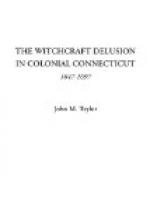“Shortly after this, a poor simple minded woman living in Fairfield, by the name of Knap, was suspected of witchcraft. She was tried, condemned and sentenced to be hanged.” SCHENCK’S History of Fairfield (1: 71).
“GOODWIFE KNAP”
This was one of the most notable of the witchcraft cases. It stands among the early instances of the infliction of the death penalty in Connecticut; the victim was presumably a woman of good repute, and not a common scold, an outcast, or a harridan; it is singularly illustrative of witchcraft’s activities and their grasp on the lives of the best men and women, of the beliefs that ruled the community, and of the crude and revolting practices resorted to in the punishments of the condemned, and especially since in its later developments it involved in controversy and litigation two of the great characters in colonial history, Rev. John Davenport, one of the founders of New Haven, and Roger Ludlow, Deputy Governor of Massachusetts and Connecticut.[I] Goodwife Knapp of Fairfield was “suspicioned.” That was enough to set the villagers agog with talk and gossip and scandal about the unfortunate woman, which poisoned the wells of sober thought and charitable purpose, and swiftly ripened into a formal accusation and indictment.
[Footnote I: Connecticut, through its Commission of Sculpture, in recognition of his services to the Colony, is to erect a memorial statue to Ludlow to occupy the western niche on the northern facade of the Capitol building at Hartford.]
Pending her trial the prisoner was committed to the house of correction or common jail for the safe keeping of “refractory persons” and criminals.
What terrors of mind and spirit must have waited on this “simple minded” woman, in the cold, gloomy, and comfortless prison, probably built of rough logs, with a single barred window and massive iron studded door, a ghost haunted torture chamber, in charge of some harsh wardsmen.
Knapp was duly and truly tried, and sentenced to death by hanging, the usual mode of execution. No witch was ever burned in New England.
From the day sentence was pronounced until the hanging took place, out in Try’s field beyond the Indian field, in view of the villagers, whose curiosity or thirst for horrors or whose duty led them there, this prisoner of delusion was made the object of rudest treatment, espionage, and of inhuman attempts to wring from her lips a confession of her own guilt or an accusation against some other person as a witch.
The very day of her condemnation, a self-constituted committee of women, with one man on it,—Mistress Thomas Sherwood, Goodwife Odell, Mistress Pell, and her two daughters, Goody Lockwood, and Goodwife Purdy,—visited the prison, and pressed her to name any other witch in town, and so receive such consolation from the minister as would be for her soul’s welfare.




